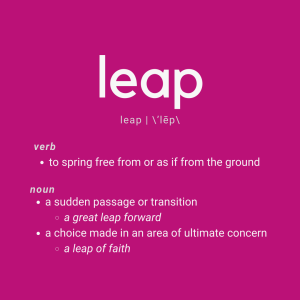Leading with our best work yet
Have you ever gotten lost in the woods or really turned-around in an unfamiliar city? Did you, while trying to figure out where you were and how to get to where you wanted to go, decide that being disoriented was probably how life would feel from this day forward? Probably not. You were lost. Even if that lasted longer than you liked, it was temporary because you didn’t label it as normal. Which is why leaders need to consider how we describe what we’re all going through very carefully.
The forest in which we currently find ourselves is the experience of COVID-19. It is not simply a forest we are strolling through; aspects of our lives are likely to change permanently. Organizations of every kind are trying to navigate this dramatic and sudden change in relationship to each other, their communities, and the global economy simultaneously and in real time. That is new for everyone but it is not normal. Language shapes our experience. In adopting the easy label of the New Normal, we may be normalizing increased stress, overwhelm, social uprising, illumination of unsustainable societal paradigms, financial instability, social isolation, and physical danger. It’s like deciding that being lost is just how things work now: oh, well… so it goes. Why would anyone want that to be our “normal” experience?
In the same breath that people describe this as the New Normal, they say they want things to go “back to normal.” Being able to touch family and friends and be in public without the fear of it endangering our health would be the best news ever. But what about the patterns or behaviors in our communities and organizations that weren’t so great? They might have been “normal,” but that doesn’t mean they were working. When we say we want things to be “normal,” we often mean “familiar.”
Leaders in every type of organization need to examine whether something is normal, familiar, or actually helps our organizations thrive. It might be that something you do is all three. It might be none of the above. If we choose to lead our teams beyond “normal,” we can lay the foundations for better work and better workplaces.
How to Re-imagine “Normal”
So, what do we do to lead well while imagining what we want normal to be? Start with these three things.
#1. Orient yourself to the recent past.
Start by remembering what your organization was doing in 2019. What was working? Think about the quantitative data that indicated success and explore the qualitative dimension of why things were going well. What values were you and your team embodying? What behaviors and interactions were you most proud of? Write it all down.
Then let your mind wander to what really wasn’t working. Were you struggling to hit your annual goals? Was there infighting within departments? How was morale? What character traits were in play here and which ones were missing? Write them down.
#2. Evaluate the present.
Stress is high and the scramble to figure out which way is up is real. That is one part of the story. Another part is that some of the people on your team may have become happier and more productive because they are able to work from home. Introverts might be thriving because extraverts aren’t always popping their heads into their cubicles and say, “Hey, got a sec?” Conversely, extraverts might be crawling out of their skin and not getting anything done because they can’t chat with colleagues while they work. Look at the things that are working well on your team and the things that are working poorly.
If you don’t know how things are going for the people you work with, ask them. Write it down.
#3. Start creating something new out of pieces that work the best.
Combine your lists. What behaviors and qualities are present when your teams feel good about their work and how it’s accomplished? How might you recognize these qualities and begin to fold them into daily operating norms? Does that create more opportunity for people to feel more engaged, more included, more creative, and successful? Great! Every day, work toward having more experiences that reinforce these feelings and outcomes than fewer.
Then combine all the stuff that has plagued your organization for too long and the stuff that creates discord and a lack of effective contribution. Stop doing those things – we can only take one plague at a time.
Pay attention to both your objective and subjective metrics for both of these lists – they are equally important. Use your leadership skills to steer your organization toward the best of what it’s done by using the best of what it’s doing now. What are your ratios of each? Your goal is, at the end of each day, to have more stuff that’s working than not.
This is not an easy task. Our lives are under completely unfamiliar levels of stress at the moment. But if we can use the best of what we’ve done with the best of what we’re doing, we can lead ourselves out of these woods just fine. And won’t it be great when that is what we mean by normal?
photo: shutterstock
This post originally appeared on ALifeofCharacter.com





